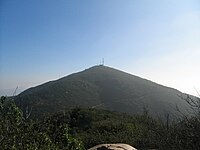| This article needs additional citations for verification. Please help improve this article by adding citations to reliable sources. Unsourced material may be challenged and removed. Find sources: "Mission Trails Regional Park" – news · newspapers · books · scholar · JSTOR (April 2011) (Learn how and when to remove this message) |
32°49′48″N 117°03′18″W / 32.830°N 117.055°W / 32.830; -117.055


Mission Trails Regional Park is a 7,220-acre (29.2 km) open space preserve in San Diego, California. The park was established in 1974. It is the sixth-largest municipally owned park in the United States, and the largest in California.
Description
| This section does not cite any sources. Please help improve this section by adding citations to reliable sources. Unsourced material may be challenged and removed. (July 2015) (Learn how and when to remove this message) |
The park consists of rugged canyons and hills, with both natural and developed recreation areas. It is the seventh-largest open space urban park in the United States, consisting of nearly 7,000 acres (28 km). The highest point is 1,592-foot-high (485 m) Cowles Mountain, which is also the highest point in the city of San Diego. The San Diego River flows through the park. The park is open every day of the year.
The park has 60 miles of hiking, mountain bike and equestrian trails, a rock climbing area, and the Kumeyaay Lake Campground with 46 camp sites adjacent to a small lake. There is also the 14,000-square-foot (1,300 m) Mission Trails Regional Park Visitor and Interpretive Center. It includes a number of exhibits, a library, and a 93-seat theater that includes a Blu-ray projection system with a large screen. The Visitor Center also includes an art gallery. The most popular trail of the park is the Cowles Mountain trail (pronounced Colz), which takes hundreds of people per day to the summit for a 360-degree panorama of San Diego County. Another popular stop is Old Mission Dam, which was built to supply irrigation water to farm land that supplied food for the Mission San Diego de Alcala, the first of the chain of missions established by Junípero Serra in California.
On December 17, 2014, West Sycamore was officially opened to the public. This increased the size of the park by just over 1,100 acres and includes 6 miles of trails. West Sycamore is located adjacent to the Scripps Ranch community and is at the very east end of Stonebridge Parkway. It is north of the main area of MTRP.
Special annual events at Mission Trails include the Amateur Photo Contest which begins in March, with entries due by the middle of April.
Natural history
The park is in the California chaparral and woodlands ecoregion. It has coastal sage and chaparral and riparian habitats and plant communities of California native plants.
Expansion
In July 2022, the City of San Diego purchased 25 acres to add onto the park. In September 2022, The Mission Trails Regional Park (MTRP) Foundation announced that it had received a 2 million dollar grant from the San Diego River Conservancy to extend the park. This proposed addition for adding more land would be within the uninhabited planning are of the East Elliott Community, north of State Route 52 and bordering the Marine Corps Air Station Miramar.
The MTRP Foundation acts as a nonprofit group dedicated to preserving, protecting, and improving the park and is receiving the grant from the San Diego River Conservancy (SDRC) since the San Diego River runs directly through Mission Trails, including Old Mission Dam which is a historic conifer for the river. The SDRC operates as an independent, non-regulatory state agency established with a similar goal to the MTRP Foundation by intending to preserve, restore, and enhance protected regions or systems in and around the river. This may also include other watershed ecological areas such as adjacent canyons.
Due to the preserve already being one of the largest urban parks in the United States, both of the new acquisition efforts will obtain ultimately more than 100 additional acres of land for the park. Both purchases would support the park's "2019 Master Plan Update" and the City of San Diego's Multiple Species Conservation Program (MSCP), which aims to preserve essential landscapes and their (largely endemic) ecosystems. Notably, the introduction of such projects which are characterized by extension of the park's borders as well as preservation of additional scenic landscapes would also support the policies of related organizations like The California Natural Resources Agency by virtue of imparting a variety of ecological benefits such as habitat conservation, and protection of wildlife corridors in addition to related areas like the San Diego River's watershed segments which are still a part of Mission Trails. This includes the small, surrounding scenic zones of Lake Murray and nearby canyons.
The expected conservancy grant is estimated to take up to two years. During this time, the MTRP Foundation will work to secure additional funding to support other land acquisition opportunities in the East Elliott Community Planning Area. Altogether, this could result in roughly 600 additional acres.
2003 Cedar Fire
A significant portion of the park was burned by the Cedar Fire in 2003. As is typical of a chaparral ecology, within a few years the park had recovered and exhibited little evidence of recent fire damage.
See also
References
- "The 150 Largest City Parks" (PDF). Trust for Public Land. 2010.
- ^ "Mission Trails Regional Park Foundation Receives $2M Grant to Acquire Additional Land for Mission Trails". Mission Trails Regional Park. Archived from the original on September 23, 2022. Retrieved May 18, 2023.
- Dawson, Danielle; Barker, Zara (July 7, 2024). "San Diego City Council approves expansion of Mission Trails Regional Park". FOX 5 San Diego & KUSI News.
- "Six years after the Fire". Mission Trails Regional Park. Archived from the original on May 5, 2012. Retrieved May 5, 2012.
Sources
- San Diego's Mission Trails Regional Park : Official Guidebook, by Pamela Crooks, 2003, ISBN 0-9706219-1-4